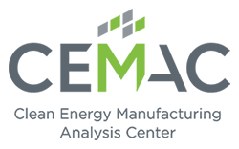When Comparing Costs of Automotive Lithium-Ion Batteries, Know the Context
May 30, 2020
By Emma Elgqvist, CEMAC Analyst
Reported measures of automotive battery costs and prices vary widely. This is in part because the technology is relatively new and the shape, size, chemistry, and packaging differ between vehicles. Also, the context for the reported values is often not clearly stated, inviting comparison of inequivalent values from multiple sources. For example, cells are often combined into packs for specific vehicles at significant added cost, so it is not appropriate to compare a cell cost with a pack cost, even if they are both expressed in the same units ($/kWh).
NREL recently developed a fact sheet that demonstrates the importance of understanding the full context of various cost and price metrics of lithium-ion (Li-ion) battery cell and cell packs. The fact sheet provides metrics for light-duty vehicle cell and cell pack market price, modeled price, modeled cost, and lab achieved costs. The data comes from market reports, CEMAC cost models, and the Vehicle Technologies Office (VTO) of the U.S. Department of Energy. At first glance, the metrics (in the figure below) can appear to contradict each other, as VTO Lab Achieved Costs are significantly lower than the others. However, the differences can be reconciled by investigating the metrics themselves, specifically by distinguishing between cost and price and the underlying assumptions, such as technology maturity.
Cost versus Price: Comparing the 2015 modeled price to observed market prices suggests that market factors—not manufacturing cost considerations—currently influence pricing decisions. This is further substantiated by comparing both the CEMAC and Bloomberg New Energy Finance (BNEF) cost modeling results to observed prices, which suggests that manufacturers have sold at or even below their costs of production in recent years. (For more on modeled cost versus price, see our earlier blog posts on this topic).
Technology Maturity: The CEMAC and BNEF cost modeling results in the chart above benchmark the 2015 cost of light-duty, plug-in hybrid electric vehicle cells and packs that were produced using commercially available technology. The VTO modeled costs, by contrast, are meant to estimate the projected commercial-scale production cost of technologies that are currently in research and development.
Comparing VTO cost targets to the 2015 CEMAC modeled cost of commercially available technology ($495/kWh) shows that the CEMAC modeled costs align with the VTO cost targets from 4 years earlier. A 3-to-5-year lag is representative of the time required to move near-commercial VTO portfolio technologies, which have been proven at the lab or pilot scale, into large-scale commercial production.
The examples above demonstrate the importance of understanding the full context of various cost and price metrics that are reported in technical papers, market research reports, and the general media—especially with respect to relatively immature technologies and markets where a standard paradigm has yet to develop. Without this context, it is not possible to reasonably compare or analyze cost and price values from multiple sources.
For more information, download the full fact sheet.

